Analyst estimates are predictions or forecasts about a company’s future financial performance that are created by equity research analysts who follow that business or industry.
Analyst estimates often take the form of quarterly, annual, or multi-year forecasts for a company’s revenue, earnings per share (EPS), operating margins, or other key metrics.
Analyst Estimate Common Terms
What are Consensus Estimates?
When financial news sources refer to a stock’s “estimates,” they’re referring to the company’s consensus analyst estimates.
Consensus estimates represent the collective wisdom of the market because they refer to the average estimate of a company’s future performance.
Consensus estimates are calculated by averaging the individual estimates of Wall Street’s sell-side investment analysts.
Instead of relying on just one analyst’s ideas, consensus estimates average many analysts’ estimates and help to smooth out the final forecast for investors.
Here’s what Alphabet’s consensus estimates look like for the next 3 years:
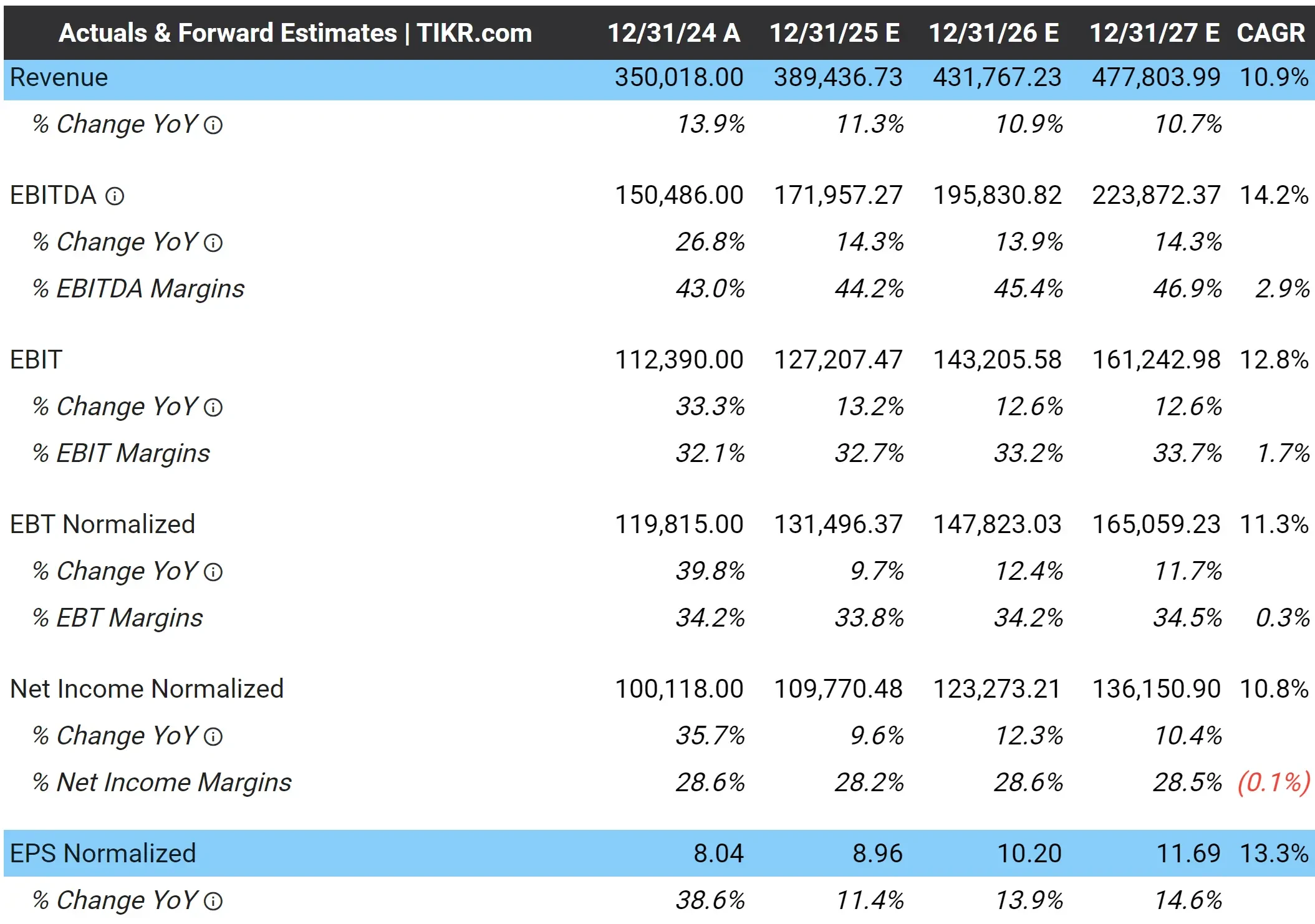
Find stocks that analysts think are undervalued today >>>
What are Price Targets?
Price targets are estimates set by analysts for the future price of a stock, typically over a 12 to 18 month period.
These targets are based on an analyst’s expectations of a company’s future financial performance, economic conditions, and market trends.
It’s important to understand that price targets aren’t guarantees of a stock’s future performance and can frequently change based on new information or market conditions.
Example: The TIKR Terminal shows that Alphabet (GOOGL) currently has a consensus target stock price of just about $216/share. That means that analysts estimate that Alphabet’s share price will reach $216 within the next 0-18 months.
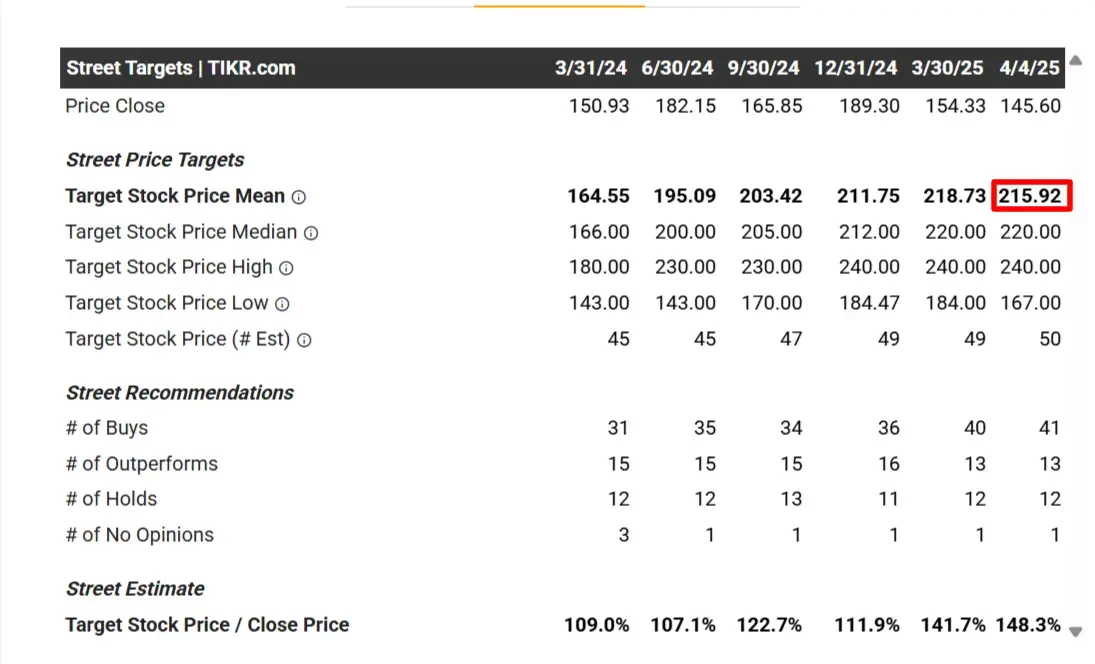
Find undervalued stocks with TIKR >>>
What Do Buy, Sell, and Hold Ratings Mean?
Analysts often accompany their estimates with ratings like Buy, Sell, or Hold, which reflect their overall recommendation for the stock:
- Buy: Indicates that the analyst believes the stock is undervalued and has strong potential for price appreciation. For long-term investors, a Buy rating suggests confidence in the company’s growth prospects over an extended period.
- Sell: Suggests that the analyst thinks the stock is overvalued or that significant risks could lead to a decline in the stock price. Long-term investors should consider whether the company’s fundamentals justify holding the stock.
- Hold: A Hold rating means that the analyst believes the stock is fairly valued. It may suggest that there is no compelling reason to buy more shares but also no urgent need to sell. For long-term investors, a Hold rating could indicate a stable company that doesn’t offer much upside but also has limited downside risk.
At TIKR, we report Buy, Sell, and Hold ratings that analysts assign to different stocks. As an example, 41 analysts gave Alphabet stock a Buy rating, while 13 rated the stock Outperform, 12 rated the stock a Hold, and 1 didn’t submit an opinion:

Find stocks that are expected to outperform today >>>
What Does It Mean to “Beat” Estimates?
“Beating estimates” means that a company’s actual financial performance exceeded its consensus estimates, which are the average of Wall Street’s sell-side analysts’ estimates.
Example: 3M (MMM) saw its share price rise 23.0% in one day after announcing earnings. This was driven by beating revenue and profit estimates and increasing its full-year profit forecast. You can see below that 3M’s actual revenue for the quarter of about $6.3 billion beat analysts’ estimates of $5.8 billion by about 2.68%:

Companies that consistently beat estimates often have management teams that are particularly strong at underpromising and overdelivering, which helps build trust over time.
It’s also important to consider why a company is beating estimates. If a company’s outperformance is due to one-time factors or cost-cutting measures that aren’t sustainable, the company might not be creating long-term value for shareholders, even if they’re beating estimates.
How Analysts Create These Estimates
Creating estimates involves a rigorous process of data analysis and forecasting. Analysts begin by gathering a wealth of information from various sources, including:
- Company Financials: Historical performance, current financial health, and growth prospects.
- Industry Trends: Overall market conditions and sector-specific trends.
- Economic Indicators: Broader economic factors that could impact the company’s performance.
- Management Guidance: Insights and forecasts provided by the company’s management.
- Competitive Landscape: Analysis of the company’s position relative to its competitors.
- Qualitative Factors: Management quality, brand strength, and competitive positioning.
From there, analysts can build models to project a company’s future revenue and earnings, and set price targets.
How Can Investors Use Analyst Estimates?
Analyst estimates can be particularly useful in several scenarios for fundamental investors:
Evaluating Growth Stocks
For companies in high-growth sectors like technology or healthcare, analyst estimates provide a glimpse into expected future performance. These estimates help investors determine whether a stock will continue growing or is potentially undervalued.
Example: Analysts expect Broadcom’s (AVGO) revenue to grow 44.0% this year and 21.2% next year. This is much stronger than historic growth:
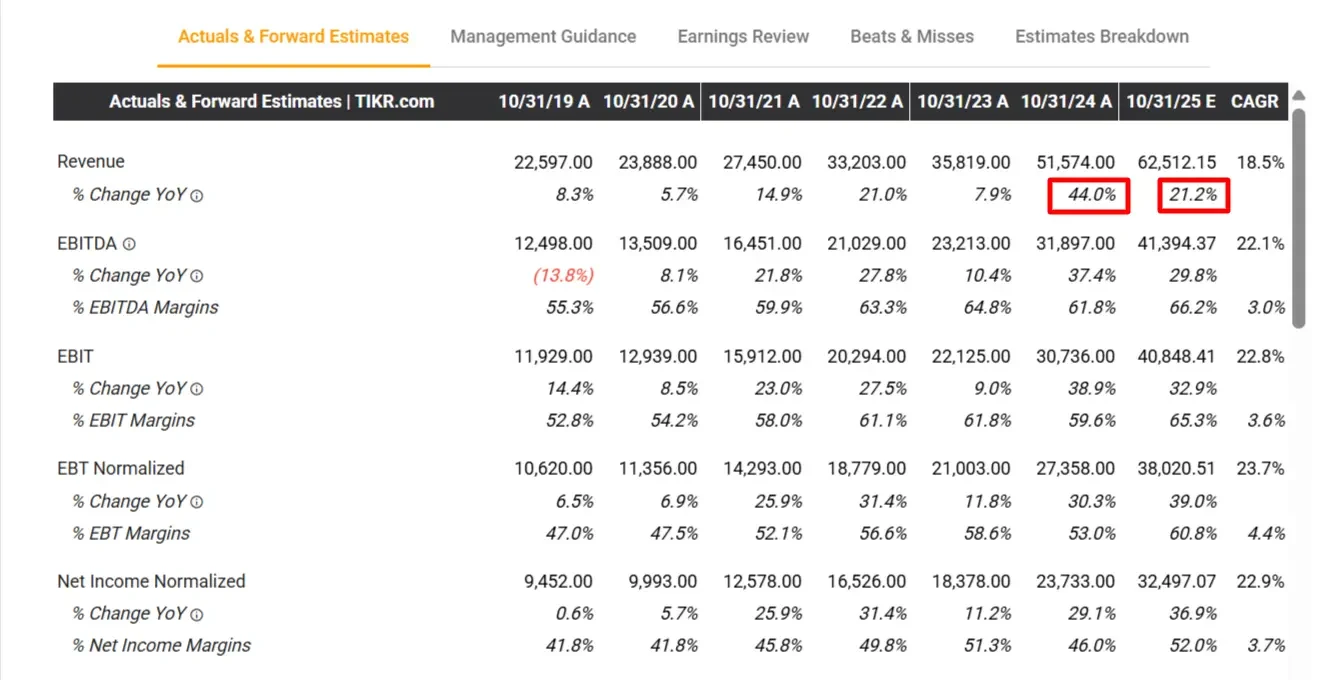
Assessing Cyclical Stocks
In industries like energy or commodities, where earnings can be volatile, analyst estimates help investors understand where a company might be in its business cycle. This information is crucial for timing investments and making decisions based on cyclical trends.
Example: Nucor (NUE) is the leading steel manufacturer in the United States. If you thought steel demand was going to increase, you could check Nucor’s analyst estimates to see if they forecast a jump in the company’s revenue:

Analyzing Turnaround Stories
Analyst estimates can help to indicate whether turnaround efforts will be successful. Investors can gauge the potential for recovery and long-term growth.
Example: Analysts expect Carnival Corporation’s (CCL) revenue to continue growing in 2024 and 2025 after the company saw a nasty revenue drop in 2020 due to Covid:
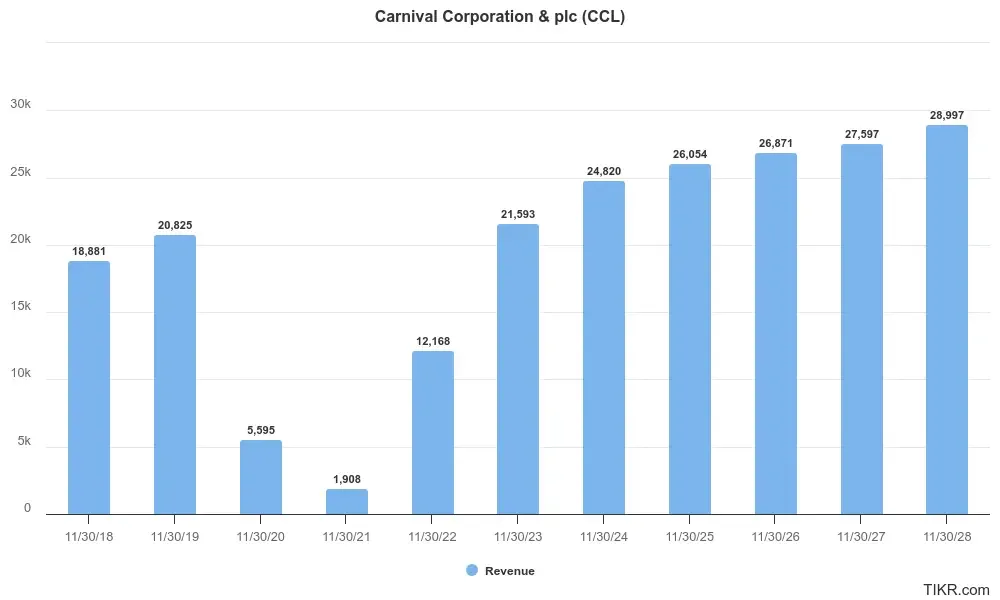
Analyze stocks fast with TIKR >>>
Comparing Companies
Analyst estimates allow investors to compare different companies within the same industry. By examining how analysts view competitors, investors can identify which companies are expected to outperform and which might lag behind.
Example: Analysts expect Pepsi (PEP) to see higher revenue growth than Coca-Cola (KO) this year, but Coca-Cola is expected to surpass Pepsi in 2025:
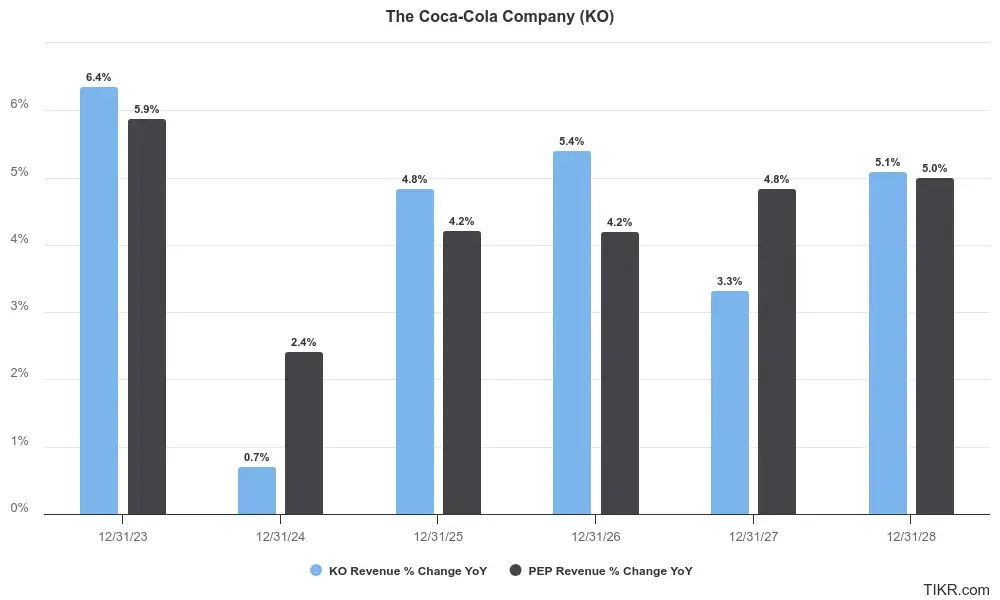
These estimates help investors better understand how the underlying business is expected to grow, which in turn helps them better understand what the stock is worth.
How Accurate are Analyst Estimates?
There are several reasons why analyst estimates can be untrustworthy:
- Bias and Conflicts of Interest: Analysts may face pressure to provide favorable estimates to maintain good relationships with company management or to attract investment banking business, leading to biased or overly optimistic forecasts.
- Overreliance on Company Guidance: Analysts often rely heavily on the guidance provided by company management. If this guidance is overly optimistic or strategically conservative to manage investor expectations, it can lead to the analyst estimates being off.
- Groupthink and Herd Behavior: Analysts may adjust their individual estimates to follow consensus estimates. Aligning estimates with the majority can help analysts avoid the potential of being wrong alone.
- Macroeconomic and Market Volatility: The world is an unpredictable place. Unpredictable changes in the broader economic environment, geopolitical events, or sudden market shifts can quickly invalidate analyst estimates.
Even though analyst estimates aren’t always accurate, consensus estimates often serve as a great starting point for forecasting a company’s future growth and valuing a company.
Investors can verify analyst estimates by comparing a company’s actual past performance with past analyst estimates. This can help investors to evaluate the accuracy and consistency of their forecasts.
Investors can verify analyst price targets on TIKR by looking at a stock’s Target Stock Price / Close Price ratio to see if analysts have historically accurately predicted the stock’s upside or downside.
Example: Today, analysts predict that Alphabet has nearly 50% upside.
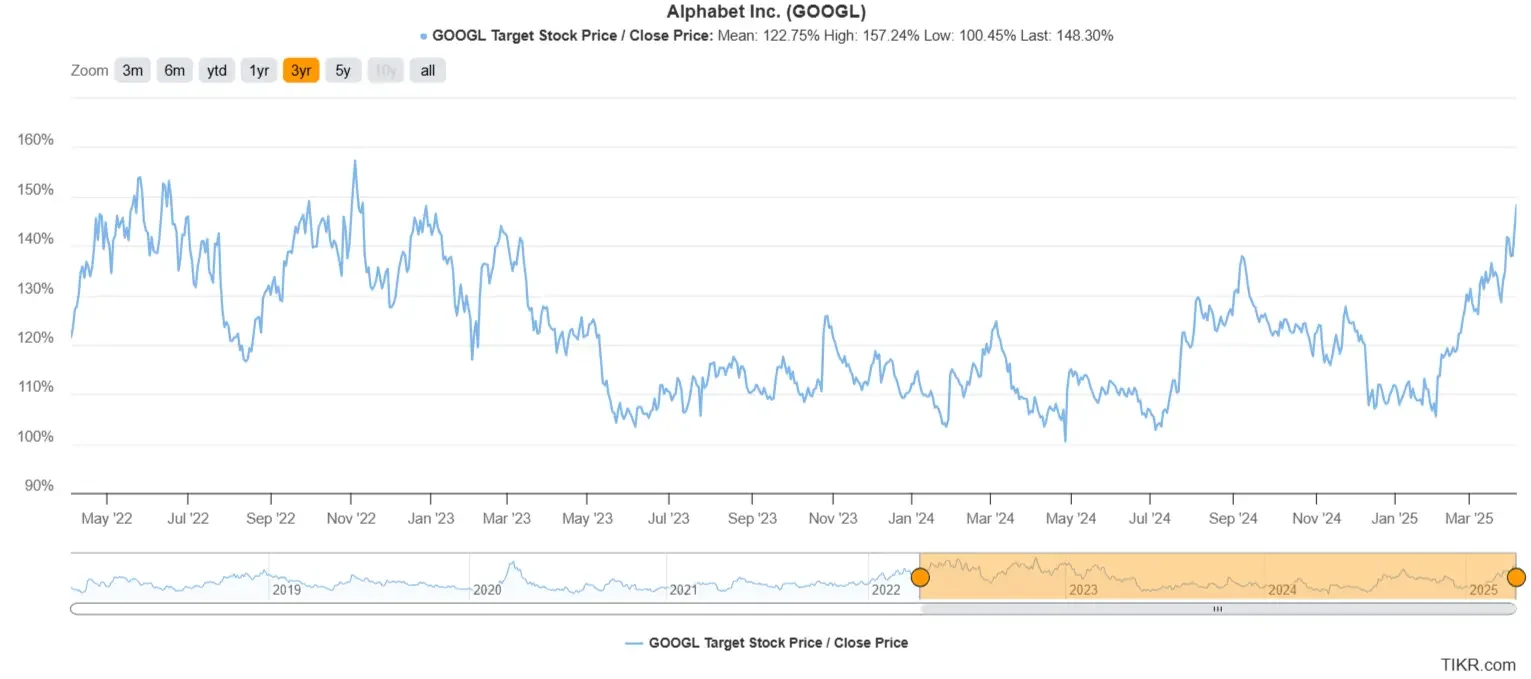
How to Use Analyst Estimates to Find Undervalued Stocks
Investors can use analyst estimates to find undervalued stocks:
- The obvious way: If a stock trades well below the consensus analyst price target, it might be undervalued. Of course, it’s important not to over-rely on analyst estimates in your stock research, but they can be a helpful piece of your research.
- Estimates suggest a higher future growth rate: If estimates suggest a higher growth rate than the company has historically achieved, investors should consider whether the company’s strategy and market conditions justify this optimism. This future growth may not be priced in, so the stock could be undervalued.
- Analyst estimates keep rising: Another helpful strategy is to track changes in analyst estimates over time. If analysts consistently revise their estimates upward, it may signal growing confidence in the company’s future prospects, which means the stock may be undervalued today.
Where Can I Find Analyst Estimates?
Investors can find analyst estimates for stocks on many different stock analysis softwares, but one of the most comprehensive and user-friendly options is TIKR.
TIKR’s Actuals & Forward Estimates tab shows up to 5 years of annual estimates for a variety of stock metrics, ranging from popular metrics like revenue and earnings to less covered metrics such as gross margins and dividends per share.

TIKR’s Earnings Review tab allows users to fully summarize the company’s earnings results for the past 5 quarters. TIKR’s Beats & Misses tab lets users see the stock’s quarterly beats and misses across over a half-dozen metrics.
Find analyst estimates in seconds with TIKR >>>
FAQ Section
What are analyst estimates?
Analyst estimates are forecasts made by equity research analysts regarding a company’s future financial performance. These typically include projections for revenue, earnings per share (EPS), and other key financial metrics.
How are analyst estimates created?
Analyst estimates are created using a combination of financial modeling, historical performance, industry trends, and management guidance. Analysts may also incorporate macroeconomic data and competitor analysis into their projections.
Why do analyst estimates matter to investors?
Analyst estimates matter to investors because they help set market expectations. A company’s stock price can react strongly when actual results differ from consensus estimates.
How accurate are analyst estimates?
Analyst estimates can be accurate in stable environments but are often subject to revision and uncertainty. Accuracy varies widely based on the sector, company transparency, and market conditions.
What are consensus analyst estimates?
The consensus estimate is the average or median forecast from a group of analysts covering a specific company. It serves as a benchmark that investors use to gauge whether a company’s reported results meet, exceed, or miss expectations.
TIKR Takeaway
For long-term investors, analyst estimates offer insights into a company’s future expected results, so investors can make more informed decisions about which stocks to buy, sell, or hold.
While analyst estimates should not be the sole factor guiding your investment strategy, they can be a helpful benchmark for evaluating a stock’s growth potential and risk profile.
The TIKR Terminal offers industry-leading financial data on over 100,000 stocks, so if you’re looking to find the best stocks to buy for your portfolio, you’ll want to use TIKR!
TIKR offers institutional-quality research for investors who think of buying stocks as buying a piece of a business.
Disclaimer:
Please note that the articles on TIKR are not intended to serve as investment or financial advice from TIKR or our content team, nor are they recommendations to buy or sell any stocks. We create our content based on TIKR Terminal’s investment data and analysts’ estimates. We aim to provide informative and engaging analysis to help empower individuals to make their own investment decisions. Neither TIKR nor our authors hold positions in any of the stocks mentioned in this article. Thank you for reading, and happy investing!

